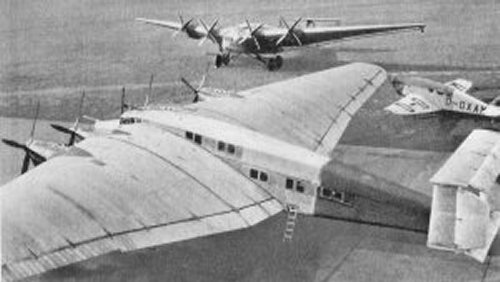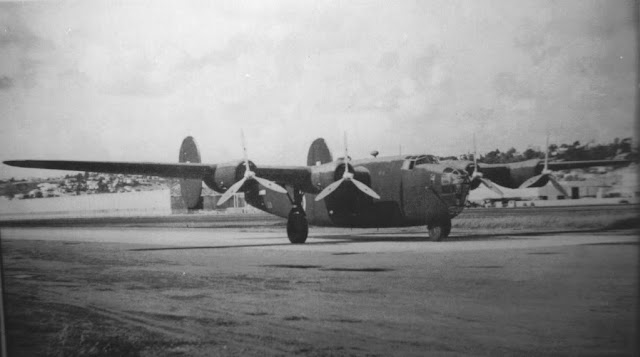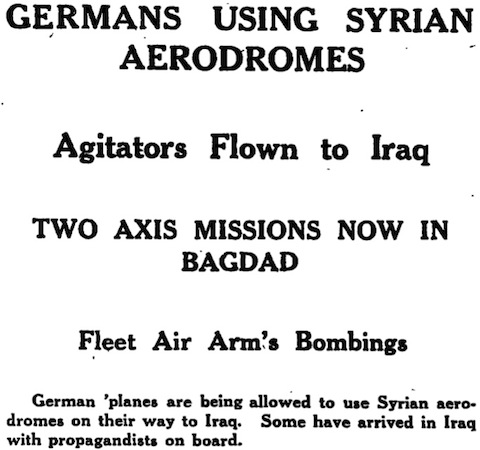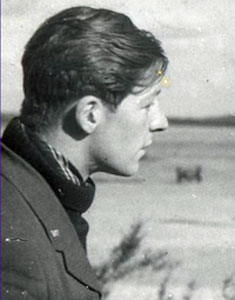Monday 19 May 1941
 |
| Battleship Bismarck, seen from the Prinz Eugen, 19 May 1941 (United States Navy Naval History and Heritage Command). |
The Rashid government in Baghdad releases a typical "everything is fine" communique:
Our bombers have attacked British tank units, which have suffered substantial losses in men and material. Our reconnaissance flights over Cineldebbana and other locations have proceeded without incident. Enemy aircraft overflew the area surrounding the capital and released several bombs over the base at Rashid without inflicting much damage.The Luftwaffe presence in Iraq is diminished by losses, but still capable of attacks. They attack Habbaniya Airfield, which is now safe from ground attack due to the presence of the Kingcol forces that have crossed the desert from Palestine.
RAF planes based in Egypt also attack fields being used by the Luftwaffe in Damascus.
European Air Operations: It is another quiet day on the Channel front, without any major operations.
 |
| "Nigel Grey Leakey VC, King's African Rifles, awarded the Victoria Cross, Abyssinia, 19 May 1941." KIA 19 May 1941 (© IWM (MH 4038)). |
This meant the end of Italian resistance in the North of Abyssinia, but enemy forces were still resisting in the South and near Gondar.The Italian surrender at Amba Alagi generally is considered the climax of the campaign in Abyssinia. However, Italian units remain at Assab, the last Italian harbor on the Red Sea, and in the lakes district inland. As illustrated below, much hard fighting remains.
Well south of Amba Alagi, at Kolito, Abyssinia, a powerful force of Italians counterattack against an Allied bridgehead. It is a fierce battle, as the Italians use both light and medium tanks to dislodge the Allies. The Italians make some progress, but once their tanks are destroyed, they retreat.
Critical in the destruction of the Italian tanks are the actions of Sergeant Nigel Leakey (cousin of the famous anthropologist) of the 1/6th Battalion, King's African Rifles, 22nd (East African) Brigade (12th African Division). Leakey dramatically drops out of a tree or a rock outcropping on top of a tank, opens the turret, and shoots the Italians inside (aside from the driver, who he forces to drive to a place of his choosing). Leakey and some of his cronies then try this again with other tanks, but during this second attempt, Leakey is shot dead. Leakey wins the Victoria Cross posthumously for his actions.
 |
| Another shot of battleship Bismarck, seen from the Prinz Eugen, 19 May 1941 (United States Navy Naval History and Heritage Command). |
Destroyers Z-23 (Commander Friedrich Böhme) and Z-16 “Friedrich Eckoldt” (Commander Alfred Schemmel) escort the Bismarck. Destroyer Z-10 “Hans Lody” (Commander Werner Pfeiffer) with the Chief of the 6th Flotilla (Commander Alfred Schulze-Hinrichs) join at 22:30. Accompanying the other ships are minesweepers, and the Luftwaffe provides air cover. The flotilla then passes through the Great Belt (a strait between Danish islands) shortly before midnight. One of three straits available, the Great Belt one offers maximum protection against the ships being observed by spies.
The Royal Navy actively patrols the Denmark Strait, which is the route for the two warships into the Atlantic. On patrol, there is cruiser HMS Suffolk. Today, cruiser HMS Norfolk (Rear-Admiral W.F. Wake-Walker, Rear-Admiral Commanding First Cruiser Squadron) departs from Hvalfjord, Iceland to relieve Suffolk temporarily while Suffolk proceeds to Iceland to refuel.
U-96 (Kptlt. Heinrich Lehmann-Willenbrock), on its fourth patrol operating out of St. Nazaire and operating about 100 miles (170 km) west of Bloody Foreland, Ireland, spots a ship early in the morning. At 03:24, Lehmann-Willenbrock identifies it as a large tanker and pumps two torpedoes into it. In fact, it is the 2922-ton freighter Empire Ridge, and the two torpedoes are overkill. The ship immediately breaks in half and sinks quickly killing 31 of the 33-man crew. The two survivors are picked up by destroyer HMS Vanquisher. After this, U-96 heads back to port.
U-69 (Kptlt. Jost Metzler), on its third patrol out of Lorient, refuels from German tanker Egerland. The Kriegsmarine has upgraded its supply network in the Atlantic in preparation for the breakout of the Bismarck and Prinz Eugen in Operation Rheinübung. U-69 has been laying mines off of Lagos and Takoradi, but now is ready to go on normal patrol looking for prey.
British 5279-ton freighter Winkfield hits a mine in the Thames Estuary and sinks. There are two deaths.
The Luftwaffe drops a parachute mine that sinks British 194-ton paddle minesweeper HMS City of Rochester in Acorn Yard, Rochester. This is not serious, however, because the ship was in the scrapyard awaiting disassembly and this is almost helpful to that process. There are no casualties.
British 3790-ton freighter Dixcove hits a mine off Courtsend in the outer Thames Estuary and is disabled. Taken under tow, the Dixcove makes it to Gravesend.
The Luftwaffe bombs Finnish 6549-ton tanker Josefina Thorden near Thorshavn and is disabled. The Josefina makes it to Kirkwall in tow and is repaired in the Tyne.
Royal Navy 23 ton armed yacht HMY Sea Angler catches fire and sinks.
Several small Royal Navy ships lay minefields PW9-PW-14 in the English Channel.
Convoy SC 32 departs Halifax bound for Liverpool.
Destroyer USS Murphy is laid down.
 |
| The third shot of battleship Bismarck, seen from the Prinz Eugen, 19 May 1941 (United States Navy Naval History and Heritage Command). |
The War Cabinet Minutes summarizes the British attitude toward the recent action south of Tobruk:
In the recent operation around Sollum, Capuzzo and Halfaya Pass we had taken all our objectives, but Capuzzo had afterwards been lost to a counter-attack by at least 40 enemy tanks. The capture of 500 German prisoners was satisfactory, while our forces in Tobruk had also done well.This is a very generous appraisal of the results of Operation Brevity by the British high command. In fact, the British accomplished virtually nothing during Operation Brevity beyond occupying Halfaya Pass, a useless acquisition in and of itself. They also had lost some ground to Italian attacks at Tobruk. It is somewhat ironic that after many instances of giving Middle East Commander General Archibald Wavell little credit for actual and meaningful victories, Winston Churchill is happy about the truly spurious victory of Operation Brevity.
However, Churchill still nags at Wavell. In another telegram today, he reminds Wavell that:
I have asked in earlier telegrams... to be told programme of using tigercubs [tanks recently arrived on the daring Tiger Convoy] when they arrive.... Tremendous risks were run to give you this aid, and I wish to be assured that not an hour will be lost in its becoming effective.Churchill goes on to give specific instances of freighters having unloaded tanks, and pointedly asks "Shall be obliged if you will tell me in detail what has happened since those cruisers were landed." Well versed in details of the conflict, Churchill also gets into such minutiae as how the "German 6-pdr gun" (apparently the very effective German 88 mm flak gun) is being used.
Churchill's private secretary, John Colville, notes in his diary that "Before going to bed the PM told me he expected the German attack on Crete to begin tomorrow." Ultra, of course, is the source of Churchill's uncanny "insight." However, according to the War Cabinet minutes, Crete did not even come up.
Royal Navy units have been on station off Crete for some time, and now they need to refuel. Thus, they head to Alexandria. While Churchill has his "suspicions" about a coming assault on Crete, he maintains a firm policy of not interfering with military dispositions at lower levels with the information he has obtained through Ultra so as to not reveal his war-winning secret. So, Force A and Force B, including Battleships Barham and Queen Elizabeth, leave the vicinity of the island.
 |
| HMS Ark Royal, which departs Gibraltar for Operation Splice today. |
An Axis convoy that includes five freighters and 6212-ton tanker Panuca depart Naples bound for Palermo en route to Tripoli. This convoy has been delayed since the 16th. An unidentified Royal Navy submarine, perhaps HMS Urge, is spotted, and the ships maneuver. This results in a collision between two of the ships, the Panuca and 8230-ton freighter Preussen. They are not badly damaged and continue on.
Royal Navy submarine HMS Unbeaten, operating off Tagiura, Libya (just east of Tripoli), attacks 1367-ton Italian freighter Silvio Scaroni. The Unbeaten's attack fails, and the Silvio Scaroni and escorts continue on from Tripoli to Benghazi.
Lieutenant-General Sir William George Sheddon Dobbie, KCB, CMG, DSO, who has been acting Governor and Commander in Chief of Malta since 24 May 1940, finally is confirmed in the position. However, Winston Churchill is not happy about one aspect of the island's defense: air defense.
Thus, Churchill has decided to replace the Air Officer Commanding RAF Malta, Forster Herbert Maynard. He notes that "Everyone here appreciates the splendid work Maynard has done... but it is felt that a change would be better now." This is never a good sign for an officer. Maynard will be given a desk job in Coastal Command in the UK. Maynard's successor is not yet identified, as the first choice turned out to have health issues - but Churchill definitely wants him gone, so is in the process of finding someone else.
It is an overcast day on Malta, and the Luftwaffe only mounts one raid on the island. Shortly after 04:00, four fighter-bombers (Jabos) bomb Valletta and St. Julian's Bay. The attack destroys a church and 15 houses in Valletta.
Australian minesweeper HMAS Pirie is laid down.
 |
| Luftwaffe paratroopers (fallschirmjäger) in Greece making final preparations for their drop on Crete in gliders on the 20th pursuant to Operation Mercury. |
German/Vichy France Relations: As part of the recent deal granting the Luftwaffe transit rights to Syrian airfields, the Germans begin releasing approximately 100,000 French POWs.
Anglo/Vichy French Relations: The minutes of the nightly War Cabinet meeting show that Churchill:
thought that we might give the French one last chance of stopping the passage of the German air force through Syria. If they did not take this chance, we should proclaim Syria to be an independent Arab State. It was relevant that Syria was territory mandated to France by the League of Nations, and that France had ceased to be a member of the League.This is an instance of Churchill using sharp reasoning about legal technicalities in order to give a veneer of legality to a desired military action, i.e., an invasion of Syria. It is a favored tactic of Adolf Hitler, too. In fact, everyone accepts that France has operated a mandate in Syria for years without any question as to its legality.
In a telegram to Canadian leader William Mackenzie King, Churchill notes that:
Clearly, there is nothing further to hope from Vichy. They have gone over into the German camp and will collaborate with Hitler to the utmost extent that French opinion will allow.Churchill suggests that Canada proceed to "complete rupture of relations" with Vichy France. France, of course, has possession of some small islands off the Canadian coast.
In a memo to Foreign Secretary Anthony Eden, Churchill states:
I do not contemplate a breach of relations between the British and Vichy Governments, but only that we shall knock them about as much as may be necessary.All of this worry about Vichy France is due to their agreement to allow Luftwaffe planes to use Syrian airfields on their way to Iraq. Hitler also is fretting about that decision, because he thinks his foreign ministry people have given up too much in exchange for that concession.
 |
| "Spitfire Mark VB, R6923 QJ-S, of No 92 Squadron RAF based at Biggin Hill, Kent, banking towards the photographing aircraft. R6923 was originally a Mark I, converted to a Mark V after serving with No. 19 Squadron and No. 7 Operational Training Unit in 1940. It was shot down over the sea by a Messerschmitt Bf 109 on 22 June 1941." This photo was taken on 19 May 1941. © IWM (CH 2929). |
Churchill also rejects a draft telegram to the governments of Australia and New Zealand regarding the state of United States "opinion" because it "was unduly depressing and seemed to take no account of the value of the American gesture in moving a large part of the Pacific Fleet into the Atlantic."
German Military: The OKW (military high command) issues another in a string of highly questionable orders covering the conduct of soldiers in upcoming Operation Barbarossa. This one is entitled "Guidelines for the Behavior of Troops in Russia." It states in part that the invasion:
demands ruthless and energetic action against Bolshevik agitators, guerrillas, saboteurs (and) Jews, and the total elimination of all active or passive resistance.Special care is to taken with prisoners, the Guidelines state, as those of Asian origin are "devious, unpredictable, underhanded and unfeeling." As with many other OKW orders issued during this period, the "Guidelines" are highly illegal under any remotely reasonable interpretation.
German Government: Adolf Hitler is buoyed by recent Italian infantry successes in North, stating:
It is quite clear that the Duce is one of the greatest men in modern history. He has extracted from the Italian people every ounce of what there was to be extracted—and what he has extracted from the Italian people is quite marvelous. If he did not get any further, it was simply because he had reached the extreme limit of their capabilities. After him there will not be another with his energy and talents for a long time, so events in Italy will definitely run downhill later.Hitler does not spend much time worrying about Operation Mercury. As his recent Directive made clear, he considers it a minor operation that is certain of success.
US Government: New York City Mayor Fiorello H. La Guardia appointed head of the new Office of Civilian Defense (OCD). This is the national agency responsible for preparing for blackouts, air raid wardens, sirens, and shelters in case of enemy air raids. From this point forward, La Guardia - who has a fan in President Roosevelt - will remain the Mayor of New York, shuttling back and forth with three days in Washington and four in the city. At this time, the OCD is an organization designed more to stir interest in the war rather than a real project, because there is little chance of any air attacks on the continental United States (and Hawaii and Alaska are not yet states at this time).
 |
| "Panoramic view of a group portrait of the 51st Training Battalion, Battery "A" at Camp Callan, May 19, 1941, WWII training camp for coast artillerymen. Shows four rows of soldiers, the first row seated, others standing; flag, center, background with emblem and letters "RTC 51A"; buildings in the background. Camp Callan (San Diego, Calif.); 1941." California State Library. |
As soon as the enemy forces in Cyrenaica have been destroyed, as they should be, having regard to our large numerical superiority in troops, artillery and tanks and the Air reinforcements we are sending, and provided Crete is held, we should invade Syria in force unless in the meanwhile a favourable situation has been created by the internal action of the Syrian Arabs.As can be seen from later events, Churchill's prerequisites for an invasion of Syria will be discarded as they are wildly optimistic.
 |
| Life magazine, 19 May 1941. Ruth Ownbey on the cover. |
Future History: Nora Ephron is born in New York City. The family soon moves to Beverly Hills, and after graduating from Wellesley College, she works briefly as an intern in the John F. Kennedy White House as a mail girl. She then embarks on a long career as a writer, which includes a stint writing about gossip in the New York Post, and marries journalist Carl Bernstein. This makes her privy to many secrets of Bernstein's Watergate coverage, including the identity of "Deep Throat" (Mark Felt), though nobody believes her when she tells them until Felt himself finally admits to it shortly before his passing. A famous writer and director with numerous awards and highly praised films, including "Sleepless in Seattle" (1993) and "When Harry Met Sally" (1989), Ephron passes away at age 71 on 26 June 2012 from pneumonia. There now is a Nora Ephron prize awarded by the Tribeca Film Festival for female writers who offer "a distinctive voice."
Tania Mallet is born in Blackpool, England. She becomes a model and actress who is best known for playing the role of Tilly Masterson in "Goldfinger" (1964). She is a cousin of actress Helen Mirren.
May 1941
May 1, 1941: British Hold Tobruk
May 2, 1941: Anglo-Iraq War
May 3, 1941: Liverpool Hammered
May 4, 1941: Hitler Victory Speech
May 5, 1941: Patriots Day
May 6, 1941: Stalin In Command
May 7, 1941: May Blitz
May 8, 1941: Pinguin Sunk
May 9, 1941: U-110 Captured
May 10, 1941: Hess Flies Into History
May 11, 1941: The Hess Peace Plan
May 12, 1941: Tiger Arrives Safely
May 13, 1941: Keitel's Illegal Order
May 14, 1941: Holocaust in Paris
May 15, 1941: Operation Brevity
May 16, 1941: Blitz Ends
May 17, 1941: Habbaniya Relieved
May 18, 1941: Croatia Partitioned
May 19, 1941: Bismarck at Sea
May 20, 1941: Invasion of Crete
May 21, 1941: Robin Moore Sinking
May 22, 1941: Royal Navy Destruction Off Crete
May 23, 1941: Crete Must Be Won
May 24, 1941: Bismarck Sinks Hood
May 25, 1941: Lütjens' Brilliant Maneuver
May 26, 1941: Bismarck Stopped
May 27, 1941: Bismarck Sunk
May 28, 1941: Crete Lost
May 29, 1941: Royal Navy Mauled Off Crete
May 30, 1941: Sorge Warns, Stalin Ignores
May 31, 1941: British Take Baghdad
2020



















